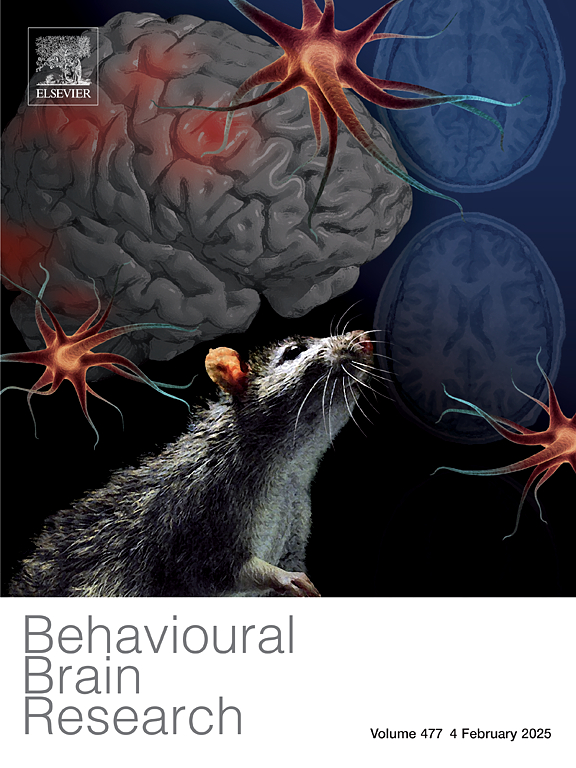Overexpression of S100B promotes depressive-like behaviors in stroke-induced rats by modulating the PI3K/AKT/NF-κB pathway
IF 2.6
3区 心理学
Q2 BEHAVIORAL SCIENCES
引用次数: 0
Abstract
Post-stroke depression (PSD) is a common complication following a stroke, primarily characterized by low mood, cognitive sluggishness, and sleep disturbances. Currently, the precise pathogenic mechanisms underlying PSD remain elusive. Research indicates that S100B protein levels may serve as a specific biochemical marker of organic brain injury, with significantly elevated serum S100B levels noted in patients with ischemic stroke, depression, and schizophrenia. S100B facilitates apoptosis through various cellular signaling pathways and is implicated in inflammatory responses, thereby participating in the pathophysiology of numerous diseases. Nonetheless, the role of elevated S100B expression in PSD remains unclear. This study used a PSD rat model created by combining MCAO and CUMS to evaluate depressive behaviors. The expression of S100B and proteins associated with the PI3K/AKT/NF-κB signaling pathway was analyzed, while changes in inflammatory factors such as IL-1, IL-6, and TNF-α were quantified using ELISA. The findings demonstrated that the combination of MCAO and CUMS effectively induced depressive-like behaviors in the rats. In the PSD rat model, overexpression of S100B may inhibit the PI3K/AKT pathway and activate the NF-κB signaling pathway, thereby promoting the expression of inflammatory factors such as IL-1, IL-6, and TNF-α, which exacerbate brain tissue damage. However, the administration of S100B inhibitors improved depressive-like behaviors in PSD rats and reversed the alterations in the aforementioned signaling pathways and inflammatory factors. These findings advance the understanding of PSD pathogenesis and suggest therapeutic strategies.
S100B过表达通过调节PI3K/AKT/NF-κB通路促进脑卒中大鼠抑郁样行为
脑卒中后抑郁(PSD)是脑卒中后常见的并发症,主要表现为情绪低落、认知迟钝和睡眠障碍。目前,卒中后抑郁的确切致病机制仍难以确定。研究表明,S100B 蛋白水平可作为脑器质性损伤的特异性生化标志物,缺血性脑卒中、抑郁症和精神分裂症患者的血清 S100B 水平明显升高。S100B 通过各种细胞信号通路促进细胞凋亡,并与炎症反应有关,因此参与了多种疾病的病理生理学研究。然而,S100B 表达升高在 PSD 中的作用仍不清楚。本研究使用结合了 MCAO 和 CUMS 的 PSD 大鼠模型来评估抑郁行为。研究分析了S100B和与PI3K/AKT/NF-κB信号通路相关的蛋白质的表达,并使用ELISA对IL-1、IL-6和TNF-α等炎症因子的变化进行了量化。研究结果表明,MCAO和CUMS的组合能有效诱导大鼠的抑郁样行为。在 PSD 大鼠模型中,S100B 的过度表达可能会抑制 PI3K/AKT 通路,激活 NF-κB 信号通路,从而促进 IL-1、IL-6 和 TNF-α 等炎症因子的表达,加重脑组织损伤。然而,服用 S100B 抑制剂可改善 PSD 大鼠的抑郁样行为,并逆转上述信号通路和炎症因子的改变。这些发现加深了人们对 PSD 发病机制的理解,并提出了治疗策略。
本文章由计算机程序翻译,如有差异,请以英文原文为准。
求助全文
约1分钟内获得全文
求助全文
来源期刊

Behavioural Brain Research
医学-行为科学
CiteScore
5.60
自引率
0.00%
发文量
383
审稿时长
61 days
期刊介绍:
Behavioural Brain Research is an international, interdisciplinary journal dedicated to the publication of articles in the field of behavioural neuroscience, broadly defined. Contributions from the entire range of disciplines that comprise the neurosciences, behavioural sciences or cognitive sciences are appropriate, as long as the goal is to delineate the neural mechanisms underlying behaviour. Thus, studies may range from neurophysiological, neuroanatomical, neurochemical or neuropharmacological analysis of brain-behaviour relations, including the use of molecular genetic or behavioural genetic approaches, to studies that involve the use of brain imaging techniques, to neuroethological studies. Reports of original research, of major methodological advances, or of novel conceptual approaches are all encouraged. The journal will also consider critical reviews on selected topics.
 求助内容:
求助内容: 应助结果提醒方式:
应助结果提醒方式:


